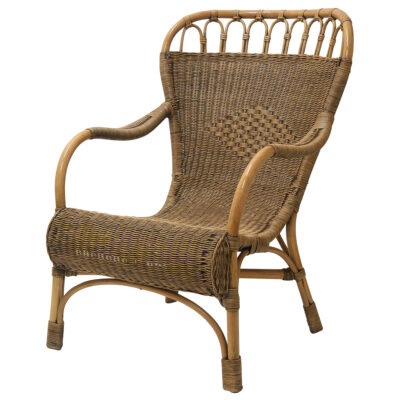
The History of Wicker
The word wicker is believed to be of Scandinavian origin: wika which means to bend in Swedish, and vikker meaning willow. Wicker is not a material in itself, but rather an overall classification of furniture woven from any one of a variety of materials such as cane (rattan), willow, bamboo, reed etc.
The oldest surviving pieces of wicker furniture date from the Egyptian Empire. These pieces include chests made of reed and rush, wig boxes of reed and papyrus, and wicker hassocks and chairs.
Natural Wicker Furniture
Wicker is a weaving process, not a material. The primary material used for indoor furniture is cane or rattan, cane or rattan being the same material by two different names depending which area of the world you are in. Cane is one of the oldest natural materials used to make natural wicker furniture.
Cane is a solid climbing vine that grows predominately in the tropical rain forests of Indonesia and South-East Asia. It commonly grows to lengths of over 150 meters and is predominately processed into sizes ranging from 2.5 mm to 50 mm, and can be harvested annually. Within the cane family, there are several hundred different varieties. Cane, unlike bamboo, is a solid core vine which makes it ideal for use in making furniture and is a naturally renewable resource.
Unlike bamboo which is hollow, Cane is solid. Round Cane poles(18 – 50 mm dia.) are used to make the frame of the furniture. They are steamed, shaped into a form of the desired shape. The large poles are processed down to smaller sizes (2.5 mm – 4mm dia.). To make “wicker” furniture we take the smaller sizes of cane and weave it to the frame – wicker is a weaving process.
The weaving of natural materials is an ancient tradition, one which modern machines cannot duplicate. The weaving of wicker cane furniture is still to this day done by hand.
The natural wicker furniture that has spent many summers on an open front verandah were never intended to withstand the elements. Sun bakes the fibers leaving them dry and brittle, moisture can loosen joints and warp frames. In other words, natural wicker furniture was made for indoor use.


All Weather Wicker
All Weather Wicker is a NEW generation of wicker furniture now available, well suited to our outdoor Australian lifestyle. At the same time, it possesses all of wicker’s visual virtues with a timeless, welcoming charm.
Our All Weather Wicker is made with aluminum frames which are treated to withstand the elements, not steel which will rust. The “wicker” for weaving is actually synthetic resins that are then hand woven onto the aluminum frames, using the same process as natural wicker furniture.
All Weather Wicker furniture is easy to maintain, and will give you many years of enjoyment and can be used indoors and outdoors.
Care & Maintenance
NATURAL WICKER FURNITURE
The best method being to dust regularly with a soft cloth, a soft brush, or vacuuming the piece with the brush attachment of a vacuum cleaner. A soft bristled tooth brush is ideal for those hard to get places. Periodically wipe it down with a soft damp cloth followed by a light application of a good furniture polish for sheen and protection. If your wicker has become badly soiled, use water and a mild soap solution, rinse and let dry followed by a coat of natural lacquer. Your natural wicker furniture will look new again.
ALL WEATHER WICKER
Use only a mild soap and water solution and rinse thoroughly. Do not store furniture upside down as water may accumulate. To extend the life of your furniture, store indoors during months of non use.
Warranty
NATURAL WICKER FURNITURE
Our Natural Wicker Furniture has a two year warranty from date of purchase against all defects in materials and workmanship of the frames only, NOT weaving.
ALL WEATHER WICKER FURNITURE
Our All Weather Wicker Furniture has a two year warranty from date of purchase against all defects in materials and workmanship.

 Cart is empty
Cart is empty 